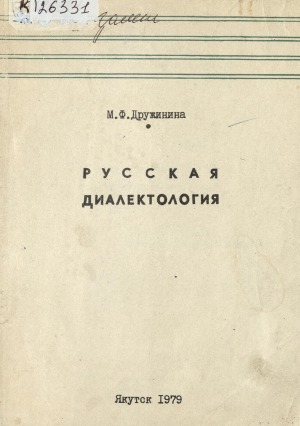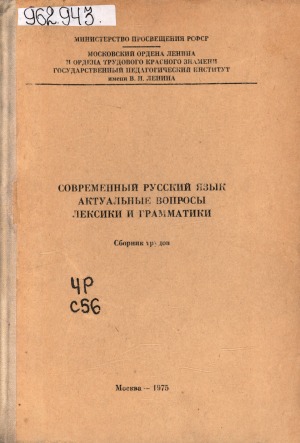Издательство: Учпедгиз
Год выпуска: 1938
Серия, номер выпуска: Кн. 3
Количество страниц: 246 с.
- Русский язык > Русский язык в Республике Саха (Якутия),
- Языки народов Якутии > Русский язык > Русский язык в РС(Я),
- Языкознание. Филология. Художественная литература,
- КНИГАКАН > Все народы > Эвенки (тунгусо-маньчжурская группа языков) > Образование. Воспитание,
- ШКОЛА > Предметные подборки > Языкознание > Русский язык,
- ШКОЛА > Педагогу > Методика преподавания дисциплин > Гуманитарные науки.
Количество страниц: 11 с.
- Языкознание. Филология. Художественная литература > Литература. Литературоведение > Теория литературы. Изучение литературы. Литературная техника > Художественная литература на отдельных языках > Якутская (саха) литература,
- Языкознание. Филология. Художественная литература > Языкознание и языки. Лингвистика > Русский язык,
- НАУКА ЯКУТИИ > ЯЗЫКОЗНАНИЕ. ФИЛОЛОГИЯ. ЛИТЕРАТУРОВЕДЕНИЕ. ХУДОЖЕСТВЕННАЯ ЛИТЕРАТУРА > Языкознание и языки. Лингвистика,
- НАУКА ЯКУТИИ > ЯЗЫКОЗНАНИЕ. ФИЛОЛОГИЯ. ЛИТЕРАТУРОВЕДЕНИЕ. ХУДОЖЕСТВЕННАЯ ЛИТЕРАТУРА > Литература. Литературоведение.
Аlexei Kulakovsky devoted his whole life to his people. His artistic works, scholarly works on Yakut linguistics, folklore, ethnography are not studied in full and arouse the interest of specialists. The article studies the use of Russian borrowings in Kulakovsky's works. In his poetry, a special place is occupied by works about Yakut women, which reveal the problem of everyday life, fate and hard life of a Yakut woman of the early twentieth century. At the same time, among the poet's works one can find pieces that reveal the beauty, elegance and morality of a Yakut girl. In this regard, according to our observations, in the dilogy "Kuorat kyyha" ("A town girl") and "Kuorat kyrgyttara" ("Town girls"), Kulakovsky presents the image of Yakut girls, their living conditions, as well as quite prosperous life of local youth of that time. Moreover, this dilogy is an artistic source testifying to the beginning of the period of social development of Yakutia in the 1920s, the special spirit and structure of that time. The changes taking place in the life of Yakut society are also reflected in the language in general. This is confirmed by the abundance of borrowed words from the Russian language, confirming the renewal of society as a whole.
Сивцева, Е. Д.
Заимствования из русского языка в произведениях А. Е. Кулаковского "Городская девушка" и "Городские девушки" / Е. Д. Сивцева, В. Е. Степанова ; Северо-Восточный федеральный университет им. М. К. Аммосова // Вестник Северо-Восточного федерального университета им. М. К. Аммосова. Серия "Вопросы национальных литератур". - 2024. - N 4 (16). - С. 108-118. - DOI: 10.25587/2782-6635-2024-4-108-118
DOI: 10.25587/2782-6635-2024-4-108-118
Количество страниц: 13 с.
This article is devoted to the assessment of the implementation of Article 35 of the Law “On Languages in the Sakha Republic (Yakutia)” on the signs of institutions of the Megino-Kangalassky District. The linguistic situation in the Russian northeast is currently the subject of many studies, which requires special attention from the state. Legal protection of the language plays an important role in preserving the cultural heritage and identity of the Sakha people. It should be noted that the Law “On Languages in the Sakha Republic (Yakutia)”, adopted on October 16, 1992, legislatively regulates the use of the Sakha language, but its implementation has not yet been completed. This study will reveal the level of implementation of the regional law in Megino-Kangalassky District. To identify the level of implementation of the regional law, let us start with the functioning of article 35 of Chapter IV. Names of administrative-territorial units, personal names, signs and information of the Law “On Languages in the SR(Y)”. The relevance of the study lies in the fact that errors are still observed in the texts of bilingual signage when translating from Russian into Yakut. Therefore, the identification of translation errors in the signage of organizations in Megino-Kangalassky District can later be used in the development of the correct design of the text of signage in the Yakut language. The main purpose of the work is to identify translation errors on bilingual signs in Megino-Kangalassky District. To achieve this goal, the following tasks were performed: the collection of material was carried out, namely, photographing signage; the analysis of the collected data was carried out to identify translation errors; the classification of translation errors into five groups of normative language errors was carried out. At the end of the work, an adjusted Russian-Yakut translation of signage was proposed, which allows not only to identify problems in the design of bilingual signage, but also to suggest ways to solve them to improve the linguistic situation in the area. The results of the study may be useful for further development of a unified signage design structure.
Герасимова, Е. С.
Типы переводческих ошибок на двуязычных вывесках организаций Мегино-Кангаласского улуса Республики Саха (Якутия) / Е. С. Герасимова, М. А. Андросова ; Северо-Восточный федеральный университет имени М. К. Аммосова // Вестник Северо-Восточного федерального университета им. М. К. Аммосова. Серия "Алтаистика". - 2024. - N 4 (15). - С. 85-97. - DOI: 10.25587/2782-6627-2024-4-85-97
DOI: 10.25587/2782-6627-2024-4-85-97
Количество страниц: 12 с.
- Языкознание. Филология. Художественная литература > Языкознание и языки. Лингвистика > Якутский (саха),
- Языкознание. Филология. Художественная литература > Языкознание и языки. Лингвистика > Русский язык,
- НАУКА ЯКУТИИ > ЯЗЫКОЗНАНИЕ. ФИЛОЛОГИЯ. ЛИТЕРАТУРОВЕДЕНИЕ. ХУДОЖЕСТВЕННАЯ ЛИТЕРАТУРА > Языкознание и языки. Лингвистика.
Based on the analysis of a large volume of translations of texts of different styles and genres, this article formulates the principles and guidelines for establishing rules for transcription and transliteration in Russian of specific sounds and letters of the Yakut language. The relevance of the study lies in the fact that the current rules for the transcription of geographic names were approved half a century ago in the “Instructions for the Russian translation of geographical names of the Yakut ASSR”. With the exception of cartography and reference books of the administrative and territorial structure of the republic, they are not observed anywhere. In this regard, there is a need to revise these rules, taking into account the vast translation experience and achievements of Yakut linguistics, to approve new rules, and to develop mechanisms for state and public control over their observance. The article defines the difference between transcription and transliteration in the case of common alphabets of the contacting languages; formulates the principles of transmitting specific sounds of the Yakut language via transcription and transliteration by means of the Russian language; and develops guidelines in accordance with the formulated principles. In the first part, the article provides a brief overview of the current legal acts governing the spelling of Yakut geographical and personal names. It also briefly analyses the linguistic foundations of the current rules set out in the Instructions. In addition, the article describes the results of the analysis on transcribing Yakut non-equivalent vocabulary in different years by different teams of translators. These are the translations of 12 olonkho, the historical novel “Remote Vilyui” by Vasily Dalan, as well as the material collected in the reference books of borrowed words by Professor Nikolay Samsonov. While writing this article, the author relied on the provisions of the general theory of translation developed by professor Dmitry Ermolovich and set out in his monograph, and also refers to the results of research by Yakut phoneticians Dyachkovsky and Alekseev, methodologists Samsonova and Dmitrieva. The principles established in this article and the recommendations developed on their basis for the translation of specific sounds of the Yakut language into Russian, in the author’s opinion, will contribute to the preservation of the historical memory of the Sakha people because they translate with the most care the graphic appearance of the original word in the context of the common alphabets of the contacting languages.
Васильева, А. А.
Принципы и правила передачи на русский язык специфических звуков якутского языка / А. А. Васильева ; Северо-Восточный федеральный университет имени М. К. Аммосова // Вестник Северо-Восточного федерального университета им. М. К. Аммосова. Серия "Алтаистика". - 2024. - N 4 (15). - С. 73-84. - DOI: 10.25587/2782-6627-2024-4-73-84
DOI: 10.25587/2782-6627-2024-4-73-84
Количество страниц: 7 с.
- Языкознание. Филология. Художественная литература > Языкознание и языки. Лингвистика > Русский язык,
- НАУКА ЯКУТИИ > ЯЗЫКОЗНАНИЕ. ФИЛОЛОГИЯ. ЛИТЕРАТУРОВЕДЕНИЕ. ХУДОЖЕСТВЕННАЯ ЛИТЕРАТУРА > Языкознание и языки. Лингвистика,
- КНИГАКАН > Все народы > Эвены (тунгусо-маньчжурская группа языков) > Языкознание.
In today’s globalizing world, the threat of loss of minority languages is steadily growing. The importance of the study of endangered languages is due to the need to preserve unique languages and cultures as part of the spiritual and intellectual potential of mankind and is determined by the growing interest in the processes of intercultural communication in a multinational country. The languages of the indigenous peoples of the North remain little studied, even though over the twentieth century an extensive data has been collected on their dialects and speech. Today, one of the first important tasks is to create a scientific base for the revitalization of endangered languages, including the development of various types of dictionaries. The article substantiates the need of developing a new Russian-Even dictionary. The Russian-Even Dictionary, by V.I. Tsintsius and L.D. Riches, published 68 years ago, has become a bibliographic rarity today. The lexicographic description of the Even language is due to the lack of modern the Russian-Even dictionaries and the presence of unique factual material. The dictionary is conceived as a work that will present not only modern Even vocabulary, but also field and archival material on various dialects and speeches of the Even language, first introduced into the scientific circulation. The interpretations of a number of words and terms that have received new shades of meaning are revised to bring them into line with modern concepts of science and technology, the grammatical characteristics of certain lexemes, illustrated by phrasal examples which were given. With regard to the Even language, taking into the bilingualism and partial multilingualism of its ethnic speakers, the multi-dialect of the language and the presence of phonetic differences between dialects and speeches, it seems advisable to present spelling norms that normalize and codify the writing of Even words for the written language, taking with regard to existing dialectal pronunciation variants. When compiling dictionary entries, cultural factors which are taken regarding to reflect the specifics of ethnic consciousness, historical experience, and cultural traditions of the people. The results of the study can be used in various areas of the social and spiritual sphere of society - education, science, culture, art. The findings and materials will find application in the preparation of the Even language grammar, various dictionaries, in the practice of teaching the Even language and folklore in schools, colleges and universities, in the development of educational and methodological literature, which will contribute to the preservation, revival and development of the Even language.
Шарина, С. И.
Некоторые аспекты разработки русско-эвенского словаря / Шарина С. И. ; Институт гуманитарных исследований и проблем малочисленных народов Севера СО РАН // Народы и культуры Северной Азии в контексте научного наследия Г. М. Василевич : сборник научных статей / ответственный редактор Л. И. Миссонова ; редакционная коллегия: А. Н. Варламов, Н. И. Данилова, Е. Г. Маклашова [и др.] ; рецензенты: Т. В. Аргунова, Т. Г. Басангова, В. Н. Давыдов ; ответственный за выпуск М. П. Дьяконова. - Якутск : ИГИиПМНС СО РАН, 2020. - С. 245-251. - DOI: 10.25693/Vasilevich.2020.046
DOI: 10.25693/Vasilevich.2020.046
Издательство: Наука
Год выпуска: 1976
Количество страниц: 260 с.
Издательство: Наука
Год выпуска: 1974
Количество страниц: 392 с.









